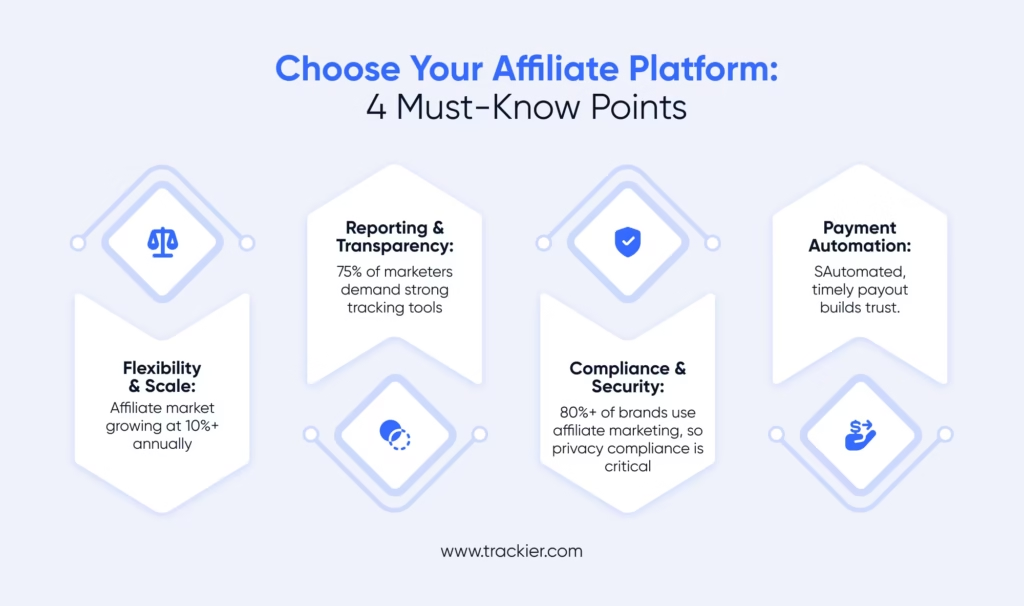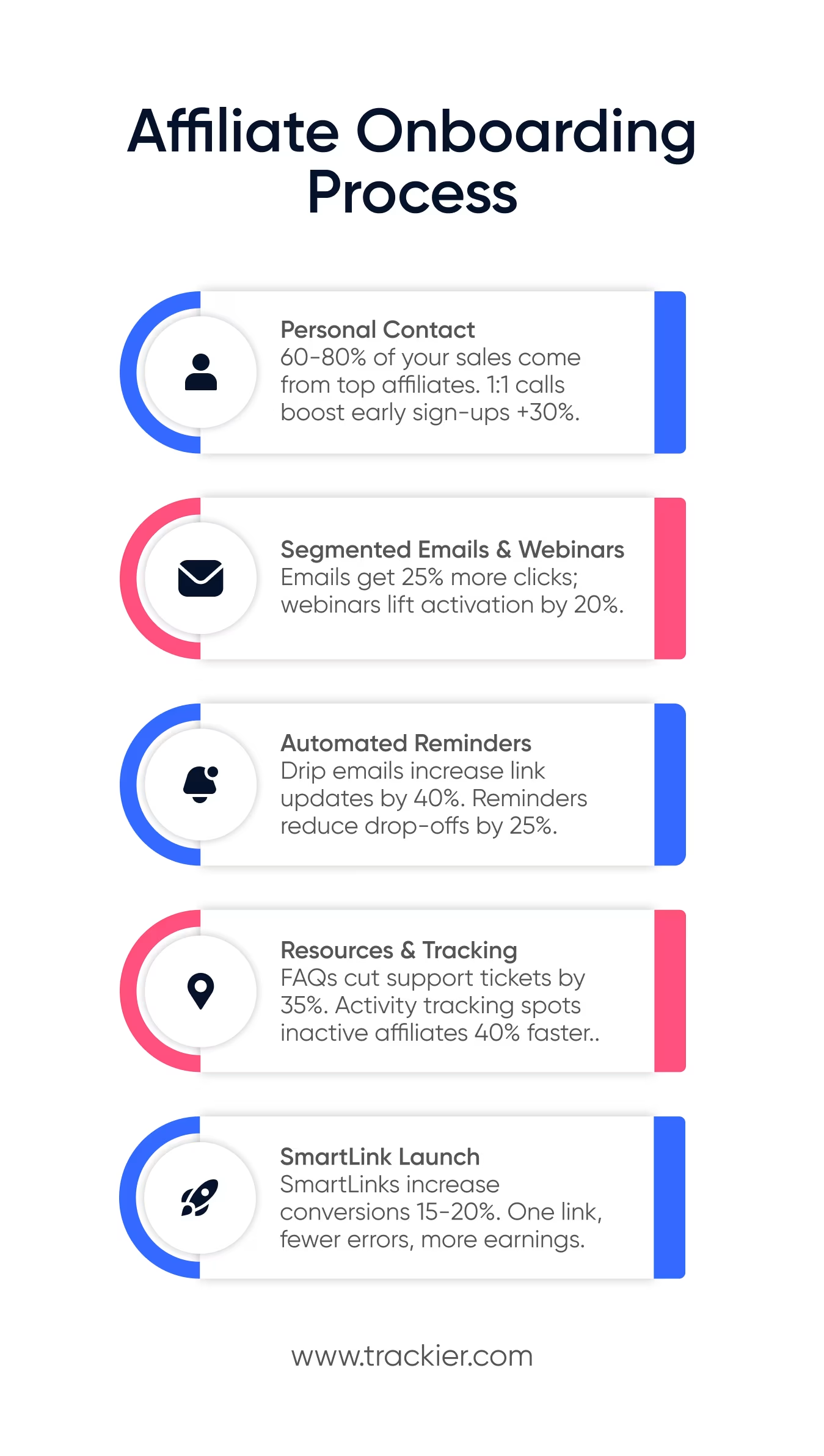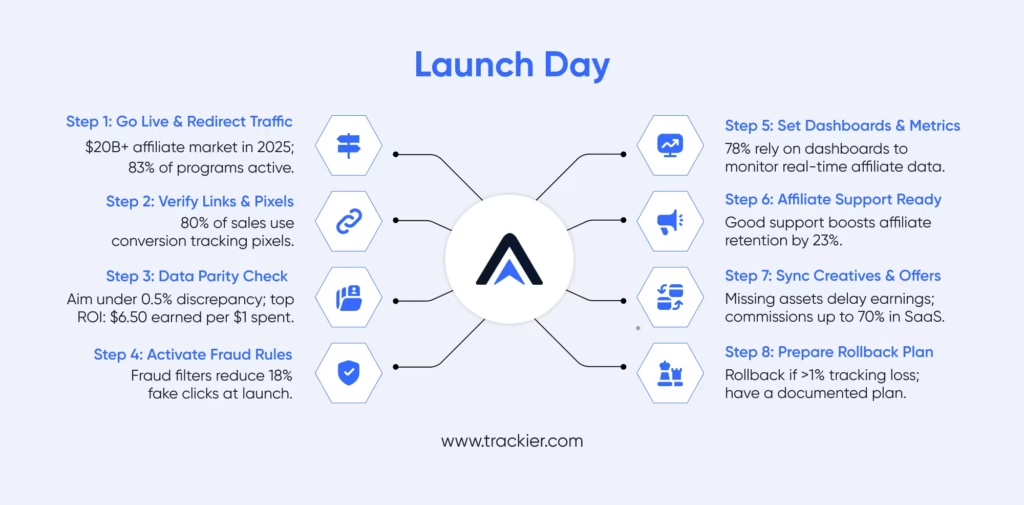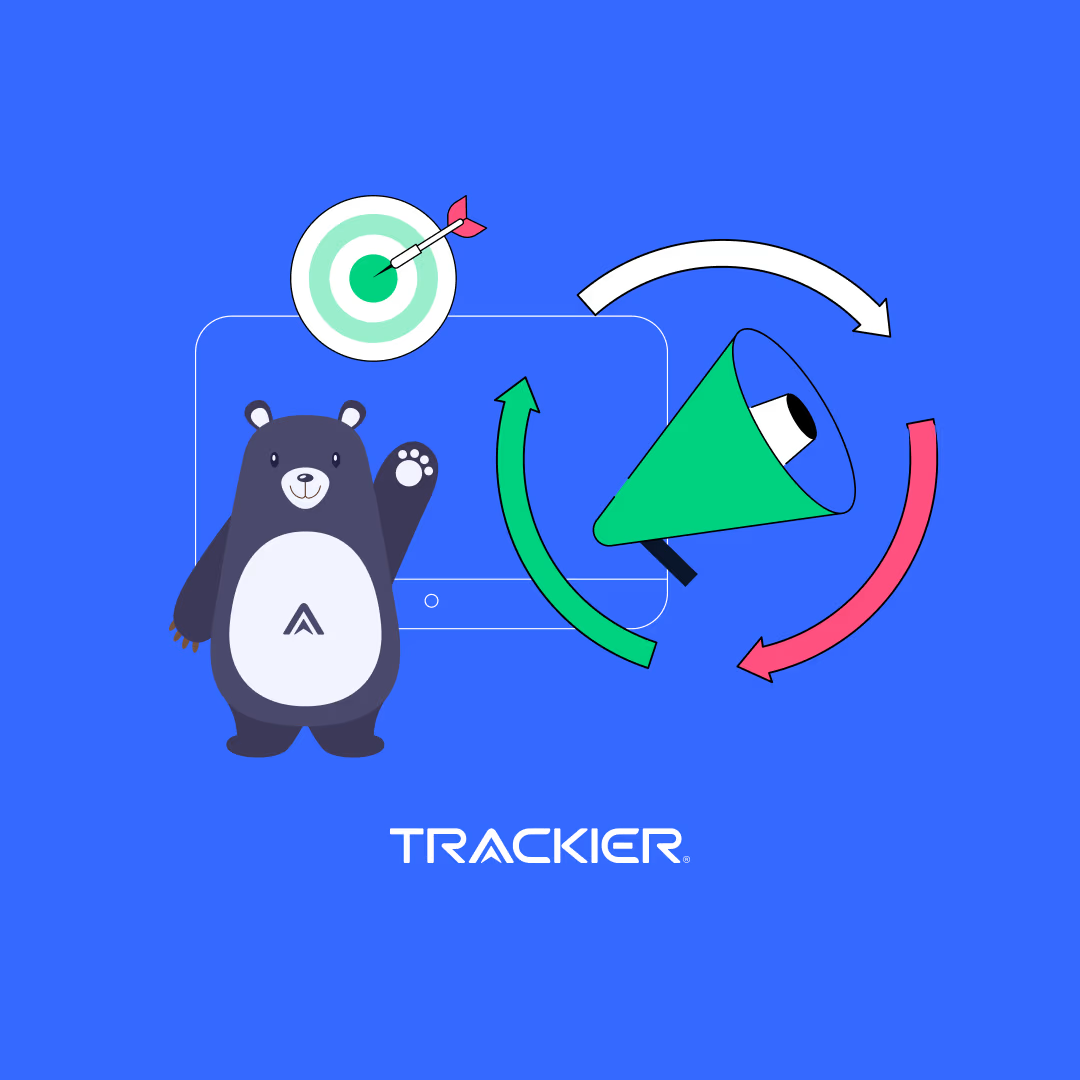Affiliate programs can make or break your campaigns: more than 65% of merchants state that affiliates were the source of 10-20% of their revenue.
Similarly, but maybe more surprisingly, partners rely on such programs tremendously, 31% of publishers report, as one of their top three revenue sources, affiliate-based income.
In either case, transparent tracking, fair payments are necessary to keep trust intact. In fact, as per the report, 28% of affiliates reported late or unpaid bills as one of their major issues, and 42% stated being unable to consistently drive traffic as a huge obstacle.
The first rule in the affiliate life cycle is to always plan rigorously and choose the correct platform. The right platform will avoid a wrong setup (incorrect tracking, late payments, complicated commission structures, and time delays) that can determine the relationship and revenue source.
As we move through this guide, you will be able to audit, decide on all team members’ onboarding, where automation can be included (like Smartlink routing and real-time dashboards), and how partners get communicated with.
These steps will assist you in having an uninterrupted program, from day one, whether you use a network or a SaaS provider like Trackier.
1. Plan and Audit the Program: “Do we really need this”?

Before you get started, stop and assess. Many brands skip the planning process and head straight to launching or re-launching an affiliate program, while having no strategy.
Take some time to define your objectives, like:
- Are you looking for more revenue?
- Brand awareness?
- Customer retention?
And see how affiliates could fit into your overall marketing strategy. Then take a look at your current situation (even if this is a new program):
A. Identify pain points
Speak with affiliates, marketing, finance, and legal, to capture any individual frustrations.
You may know that affiliates are unhappy about broken links or unfair commissions, finance may be unhappy about manual payout work, and marketing might be unhappy that there is little to no attribution data.
B. Collect data
Some or all of the data that could be on your system helps you understand any gaps that may exist.
If you have determined that you have an affiliate channel (either from an old network you joined or you installed a plugin to provide some type of affiliation), one gap assessment method to try might be a look at click-through vs. conversion rates.
Try to do a couple of end-to-end transactions to test the process.
C. Cost-benefit analysis
Are there real options that can improve the experience without a full development effort? As an example, on top of or in addition to an affiliate program offering, perhaps creating better tools (for example, automation, fraud filters) could be a consideration.
Take note of everything with enough detail if your current platform has pricing challenges or reporting. Affiliate loyalty is usually built by better tracking and quicker payment; attribution leads to revenue failures.
D. Align stakeholders
The sooner you can get legal, finance, tech, and partnerships teams involved, the better. All departments will have potential needs (e.g., IT may have to consider integrations, finance needs to be aware of payout schedules, and legal needs to make sure they have compliant terms).
You will want to compile “what must migrate” items: reports of legacy date, contract clauses, custom commission structures, and integrations (Shopify, CRM, etc.). The more you can get in writing, the better you will avoid issues later.
A simple audit checklist can be very beneficial – just identify the issues you commonly see (tracking bugs, late payments, unreported blindspots) and then get someone to investigate each issue.
Also, assess your factors (tracking accuracy, payment flexibility, compliance, etc.) so you can track your progress. This allows everyone to be on the same page and provides peace of mind knowing that you’re not just changing names of platforms, you’re changing the capabilities.
2. Choosing Your Platform and Alignment

It is now time to choose how you will actually implement your affiliate program. If you are considering a new solution (perhaps you’re going to a Trackier or other SaaS model), consider the following:
A. Flexibility and Scale
Does technology allow for your growth? Look for unlimited capacity for affiliates, layered commission rules, and dynamic offer routing.
Many traditional networks limit features or limit the amount of clicks or sales, which can eat away at margins as you begin to scale.
B. Reporting and Transparency
Today’s affiliate teams need real-time data. Platforms that can only give you a daily update or only aggregate stats hurt optimization.
Look for live dashboards and more narrow reports (even individual clicks and individual transaction views).
Some advanced solutions now provide first-party tracking (eliminating losses to browser cookies) and real-time postbacks to help data move freely through privacy restrictions.
C. Compliance and Security
Any program with global affiliate relationships must follow the relevant privacy laws (GDPR, CCPA, India’s DPDP, etc.).
If the affiliate platform cannot handle the necessary consent, data deletion requests, and secure user data, then you must keep looking.
You’ll also want to check fraud prevention features (e.g., duplicate click rejection, device fingerprinting, etc.).
The global annual losses at $37.7 billion as of 2024 data, with fraud rates averaging around 5.1% of digital ad spend and losses increasing year-on-year.
D. Payment Automation
Manual payouts create so many challenges. Pay attention to what payment tools are built-in and/or can be easily integrated with your affiliate program (e.g., automatic-batch payouts through PayPal/Payoneer, bank transfers/ACH, etc.).
Affiliates trust programs that always pay on time, completely free of errors. Key features include automated invoicing and multi-currency options with minimum thresholds.
Select platforms using these criteria. For example, Trackier’s affiliate management solution focuses heavily on first-party real-time tracking, SmartLink optimization, and compliance controls (GDPR/CCPA ready).
But no matter the solution, make sure to share your plans internally. You can use a short deck:
- Why move or launch now?
- What’s changing?
- When’s our launch?
- Get sign-off on the timeline and test and rollback plans.
Scale Faster With Trackier: Book Demo!
3. Technical Setup and Data Integration

Once you have the platform sorted and selected, it’s time to get to integration. This is typically the most complex step, so be deliberate in your approach.
A. Field Mapping
Work off a complete list of all fields you need (click ID, affiliate ID, campaign, revenue, etc.) and map those back to your system from the affiliate software.
Make sure every important thing (coupons, SKUs, custom parameters) has a mapped-out association.
B. APIs and Webhooks
Integrate your store, your CRM, your ad tools, etc. (internal or external).
For example, connect Trackier to Shopify/BigCommerce via APIs to get order data, or set up webhook post-backs from your internal database to inform the affiliate system on things like user cancellation, user refund, or click events. Test every integration.
C. Data Migration
Bring in past affiliate data, if applicable, to maintain continuity. A great way to tackle this would be to start “clean”: import only the most recent 6–12 months of clicks or conversions (noting which ones are duplicates) and keep older logs in some offline archive.
Either way, the import should be processed in batches (small sections) so you can pick up on errors as soon as they crop up. Document everything, always have a copy of the “raw” exports.
D. Testing and Validation
Before the official launch, mock up various dummy affiliate campaigns or sandbox conversions. For example, fire one fake click and conversion with known parameters, and make sure it tracks properly in both the legacy and new systems.
This side-by-side dual tracking (sending a small % of live traffic to both the legacy and new systems) offers an added layer of validation for this switch, a very good idea.
Log any discrepancies and fix any configuration mismatches as they arise. In cases like affiliate programs, even a 0.5% error in attribution is not okay, so it’s important to be detailed.
While collaborating amongst the data and dev teams, be sure to document every issue and test case; this documentation will be your troubleshooting reference.
Be clear that you want accurate postback dispositioning of the callback (retail affiliate use case) as well as accurate modelling of fields – otherwise, you risk over-paying an affiliate unintentionally in commissions.
Keep a “migration tracker” checklist, with an owner for each of the data points. And don’t forget about compliance here – cookies are fragile.
Relying on third-party tracking cookies “will only come back to hurt you in the end”. As much as possible, use server-to-server or first-party capture of affiliate conversions for a sure-fire (and compliant) way of capturing attribution.
4. Affiliate Recruitment and Onboarding

With the system ready, it’s time to start inviting your partners on board. Think about a phased communication system:
A. Tier 1 Affiliates
Your top performers and income generators. How personal can you be? Schedule 1:1 calls or send a demo link and offer them to walk through the new platform together.
Provide priority support and perhaps a targeted incentive, such as a higher commission during the first month they are transitioned onto the system, to stimulate early engagement.
B. Tier 2 Affiliates
Send segmented emails and frequently mention timelines and directions for moving forward with the switch.
You can include “getting started” guides or short instructional videos for your affiliates in this “how-to” email communication.
Invite them to upcoming group webinars and office hours, and offer them an incentive (for example, giving a small bonus to the first few partners who swap all the links) to generate an action prompt and sense of urgency.
C. Tier 3 Affiliates
Use automated email sequences whenever you can. For example, 4 weeks out, send your initial “we’re moving” notice, then a reminder email at 2 weeks and another reminder at 1 week.
On launch day, send your “Action required – update your affiliate links” email with clear direction at the beginning of the email.
After launch, you can follow up with another email at week 1 and another follow-up email at week 2 with simple prompts, or ask for more assistance.
D. Resources and Templates
Prepare email templates, conversion instructions, and an FAQ for affiliates. If your platform has a notification feature (in many cases, systems auto-notify partners of new links or payments), use it.
Track partner activity; who logged in, who updated their links, etc. If, for example, you’re using Trackier, you can take action to provide partners with a screenshot of their analytics preview so partners can validate their performance.
E. SmartLink Introduction
If your program comes with a SmartLink reference, now is the time to introduce it. A SmartLink is one affiliate URL that automatically directs every visitor to the best-performing offer as determined by their location or device.
This means you now have one link, and so do the affiliates; it makes it easy for you and easy for affiliates.
SmartLinks “monitor performance across thousands of clicks,” and “emphasize the highest converting offers to help you make more money from the same traffic.”
A basic education on the SmartLink feature can generate excitement in tech-savvy partners – all they have to do is click one link, and the system optimizes for them.
Onboard Affiliates in Minutes with the Best Affiliate Tracking Software
5. Commission Structures and Payments

Think about how you want to pay people early and try to automate as much as you can. The most common commission models are as follows:
- CPS (Cost-Per-Sale) – A fixed fee or percentage on each sale. This is standard operating procedure for e-commerce; e.g.,5-10% for every sale.
- CPA (Cost-Per-Action) – A fixed bounty for some action inside of an application, such as filling out forms, signing up, or trials (often used with fintech, insurance, or subscriptions).
- Revenue Share – A pre-determined recurring percentage of customer lifetime value – this is a common tactic for SaaS or membership businesses.
- Hybrid: Various combinations. For example, a flat bounty on the sign-up and a small share of future revenue. Or even two-tier models, whereby you can pay affiliates based on referring to other affiliates.
Whatever you decide, clarity is essential. Affiliates need to see very clearly how much and why they are being paid, and you can use commission rules to set them up once and then forget about them.
For example, you may have a tiered scheme whereby super affiliates receive a bonus on any sales over a predetermined amount.
A. Payment Terms
Net-30 (monthly) is the industry standard, giving time to process refunds, but you may consider quicker payments if cash flow allows.
The sooner you pay, the more likely affiliates will trust you – in fact, affiliates feel that faster payouts would significantly increase their loyalty.
You can automate payments/run scheduled payouts via integrations: Trackier or others can batch pay via bank transfer or PayPal.
B. Global Payments
If you are working with international partners, provide them with local-friendly methods: bank transfers (ACH, SEPA, NEFT), PayPal/Payoneer, and even e-wallets.
Furthermore, automate forex conversion/withholding calculations when possible. Appropriate systems will allow you to set regional minimum payouts and divide the transfer fees among payees.
C. Tax Compliance
Don’t forget the legal documents. For U.S. affiliates, make sure to collect Form W-9 (tax ID). For non-U.S. affiliates, have them submit W-8BEN/BEN-E to certify foreign status and to claim treaty benefits.
According to compliance experts, “ensure you are collecting the right documents and filing them correctly” when working with affiliates globally.
To avoid surprises later on, such withholding amounts could be 30%. Ideally, your platform or payment partner will store these forms and auto-generate 1099s/1042-S at year-end for your convenience.
By efficiently managing payouts and taxes, you are building trust: “clear communication, fair and timely compensation” is a foundation of long-term collaboration.
Affiliates who are compensated accurately and timely manner are much more likely to remain affiliated with your program and recommend you to others.
6. Launch Day and Live QA

Launch day is full Go-Live; from this day on, all traffic will be directed into the new system. Make sure not to just flip the switch: use this checklist to validate what happens live:
- Validation of Links and Pixels: Make sure every affiliate link (SmartLinks, deep link, banners, etc.) is working and pointing correctly. Then, test-click each major link yourself. And finally, double-check that any pixels for on-site tracking (for conversions) are firing and recording as they are supposed to.
- Data Parity Testing: For the first hour or first day, compare selected key metrics side-by-side in the old and new systems. Do click volumes and total converged counts seem roughly equal? You want 100% equivalency. Some minor variation (~0.5%) may be expected at the start, but you need to investigate any minute gaps right away.
- Fraud/Rules: Turn on fraud rules. If you have any duplicate click filters, disallow conversions from certain high-risk IPs, etc., you want these ready on day one. It is far easier to have filters in advance than to deal with the suspicious activity once it has occurred.
- Dashboard Setup: Get custom dashboards live for monitoring. Choose 3-5 “launch metrics” (clicks, conversion rate, revenue, payout accuracy, etc.) and monitor them throughout the day. So that your team members or affiliates can identify issues immediately, while keeping in mind 78% of affiliate programs use dashboards to help them make fast decisions.
- Partner Support: Be totally available to affiliates. Have a support desk (chat) ready to respond to inquiries regarding the new system. Common questions on day one might include “Where is my login?”, “How do I find my new link?”, or “Why didn’t my commission show?”.
- Creative Sync: Make sure all offer details (caps, dates, payouts) and creative assets (banners, landing pages, etc.) have been transitioned properly. Missing images or incorrect offer caps can stop revenue dead in its tracks.
- Rollback Plan: In the case of errors (e.g.,>1% tracking loss for major affiliates), ensure you can pause the migration and send traffic back. Explore and identify these rollback thresholds and have documentation ready to revert, if needed, even if for a short time.
At the end of launch week, you should have everything clean: all traffic and commissions are flowing through the platform.
Document any issues you encountered and any resolutions in an issues log for learning during the final check.
If everything went as planned, you should see the new dashboards with accurate data, which will confirm all the planning and testing you did.
7. Post-Launch Optimization and Growth

Congratulations, your affiliate program is up and running on a solid basis. However, now the real work begins: optimizing for scale and profit.
A. Segment & Incentivize Your Affiliates
Now that you have so much data, start to sort it. Plan to segment your affiliates into different performer levels: your super affiliates, your affiliates making one-time or occasional earnings, and your newbies.
By segmenting, you will be able to personalize: send your VIP partners exclusive deals, and send your other segments. Re-engagement offers additional tools to utilize.
For example, you may want to implement a tracking system for conversion rates and reward your affiliates as conversion rates exceed a set threshold.
By using thoughtful tiering and rewarding affiliates for performance, on average, engagement has significantly increased. (As marketers said, tier incentives and clear communication are “non-negotiables” to keep your affiliates engaged.).
B. Leverage SmartLinks (or automated routing)
If you haven’t already activated SmartLink funnels, do it now. With one SmartLink, all clicks will automatically be routed to the offer that has the best conversion based on that user’s region or device every time it is clicked.
This will increase your overall ROI. SmartLinks will allow you to deploy traffic that is otherwise difficult to place (for example, global push/pop ads).
C. Content and channel expansion
Do not attach to just one channel alone. Encourage affiliates to create varying content such as blog reviews, email lists, or video tutorials.
Think partnership campaigns too: co-marketing webinars, joint promotions, or even influencer sponsorships that feed your affiliate links. Each new touchpoint is another branch of the affiliate funnel.
D. Real-time data for iteration
While real-time dashboards are running, leverage them. Monitor conversion rates by offer, EPC by country, and spot underperforming campaigns.
Are certain browsers or devices not converting? Are some affiliates driving lots of clicks but no sales? It is live feedback.
Make data-driven tweaks: pause poor offers, boost ad spend on high-performing ones, and eliminate any traffic sending.
E. A/B Testing & Automation
Always test everything. A/B test the landing page or calls-to-action that your affiliates use. Try different creative assets that your affiliates can use.
Take advantage of what your platform permits you to automate: set up recurring emails or alerts to prompt affiliates (i.e., when affiliates level up, or if there are drops in activity).
Automate fraud checks and payment batching so that your team is focused on strategy versus low-value work.
F. Partner Education and Feedback
Keep the communication going. Run quarterly webinars to share tips, present new tools (like SmartLinks or new promotional assets), and answer affiliate questions.
Distribute newsletters with best practice recommendations. Survey affiliates: Is your commission plan competitive? A program that listens grows.
In short, affiliate marketing is your growth marketing strategy: continuously iterate on campaigns, reward your top affiliates, and utilize data.
A summary in one affiliate marketing analysis noted that it can be “a tactical advantage: accurate tracking, scalable payout, and more intelligent affiliate growth,” if all sequenced properly.
In practice, use your dashboards for KPI tracking (i.e., clicks, conversion rate, average order value, retention, lifetime value) and adjust budgets or incentives in real time. Over time, you will see revenues from affiliates increase and stabilize.
Optimize Your ROI With Trackier: Get Started
Conclusion: Continuous Improvement Through Affiliate Excellence
The affiliate marketing lifecycle doesn’t end with launch – it’s a loop of planning, execution, optimization, and partner engagement.
If done right, it can generate 15–30% of your total revenue and become one of your most reliable acquisition channels.
Here’s how you can take action today:
- Audit your current affiliate setup – List 3–5 gaps in tracking, payouts, or partner communication.
- Engage your top partners – Schedule a quick call with your top affiliates to understand their challenges and align incentives.
- Set up one automation – Whether it’s SmartLink routing, automated payouts, or fraud detection rules, choose a feature that saves time and increases ROI.
- Measure one KPI weekly – Pick a critical metric (EPC, CR, or payout accuracy) and track it consistently to spot quick wins.
- Book a demo – If your existing system isn’t giving you real-time insights or seamless payouts, explore a dedicated affiliate management tool like Trackier to upgrade your lifecycle.
The next cycle starts now: audit, optimize, and grow. Every small improvement compounds, and with the right tools in place, your affiliate program can scale faster and more profitably.



